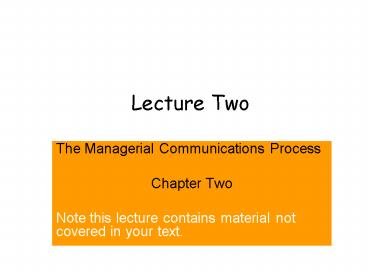Lecture Two - PowerPoint PPT Presentation
1 / 22
Title:
Lecture Two
Description:
Choose Best Symbol: Words, Voice, Gesture, Facial Expression, Action ... Use pronouns and synonyms to avoid repetition. Use transitional words or phrases (See Page 89) ... – PowerPoint PPT presentation
Number of Views:56
Avg rating:3.0/5.0
Title: Lecture Two
1
Lecture Two
- The Managerial Communications Process
- Chapter Two
- Note this lecture contains material not covered
in your text.
2
COMMUNICATION MODEL
ENCODING Choose Best Symbol Words, Voice,
Gesture, Facial Expression, Action Meaning is in
Significance to Decoder
FEEDBACK Determines if communicating to or with
people
DECODE Perceived Selective Perception (What is
Pleasant Meaning - Words dont have meaning only
people do.
3
SYMBOLS DEFINED
- Objects, acts, relationships, or linguistic
formations that stand ambiguously for a
multiplicity of meanings, evoke emotions, and
impel men to actions. (Cohen, 1976)
4
SYMBOLIC ACTS
- Actions that call forth a larger and usually
more complex set of ideas than the basic meaning
of the action, in which the intrinsic subject is
primarily a vehicle for conveying a broader
message. (Hinckley, 1990) - Symbolic acts need to be dramatic and empty of
realistic detail. (Edelman, 1964)
5
CATEGORIES OF SYMBOLS (Vaughn, 1995)
- STORIES
- RITUALIZED EVENTS
- SPECIALIZED LANGUAGE
- MATERIAL MANIFESTATIONS
- METAPHORS
- ACTIONS
6
WHY ONE-WAY COMMUNICATION
- FASTER
- SENDER MAY FEEL UNDER ATTACK
- NOISY AND DISORDERLY VERSUS APPEARANCE OF NEAT
AND EFFICIENT
7
INTERNAL PERSONALITY FACTORS
- MENTAL FILTERS
- KNOWLEDGE
- Seek Common Knowledge
- CULTURE
- Country and Company
- STATUS
- Power Issues
- ATTITUDES
- How do people see themselves, people and things.
Prejudice - EMOTIONS
- Whole Person
- COMMUNICATION SKILLS
8
STRATEGIES
- ANALYSIS
- LAYER ONE
- CLIMATE (Trust, Open/Closed)
- CULTURE (Shared Values, Beliefs, Informal, Power
Structures) Multicultural (Polycultural) - LAYER TWO
- SENDER
- Comfort, Skill, Personality, Power, Knowledge
- DECODER
- Relationship, Status,Audience Interest, Emotional
State, Skill - PURPOSE
- Social, Present Information, Persuade, Gain
Information, Defend Ones Self
9
STRATEGIES/ANALYSIS(2)
- Third Layer
- SPECIFIC CONTENT
- Positive (Good News First), Negative (Buffer
Message), Neutral - Fact (Concrete Information) / Opinion
(Assumption) - Importance to Receiver
- Controversial
- Polarization (Either-or Alternative)
- CHANNELS
- Oral
- Written
- Both
- Visual
10
STRATEGIC/ANALYSIS(3)
- Physical Environment
- Privacy (Public and Private Behavior)
- Formality (Status and Propriety - Dr. Mr. Dean)
- Physical Distance (Geographic/Time)
- Familiarity (Degree of Comfort)
- Time (Power, Status, Time is Money in USA)
- Feedback
- Affect on overall strategy
- Determine if strategy was effective
11
Metacommunication
- Unworded messages cannot be avoided
- Unworded messages have different meaning
- Unworded messages may be intentional or
unintentional - Unworded messages may get more attention than
worded message - Unworded message may provide clues (Intent,
background) - Unworded messages are influenced by circumstances
- Unworded messages can contradict
- Unworded messages can be good or bad
- Break old writing habits.
- Avoid use of old models of organizational
writing. - Look at examples on page 78
12
PRINCIPLE 5AVOID OVERUSED OR HACKNEYED PHRASES
OR JARGON
- Hackneyed
- At your earliest convenience
- Pursuant to
- Thank you in advance
- Jargon
- Check your skills handout
- (See examples on page 79 and 78)
13
PRINCIPLE 6 Use Positive Words That Convey
Courtesy
- Minimize negative information
- State information positively
- Avoid gender terms
- Check page 82 and 83
14
PRINCIPLE 7Use a Conversational Style
- Everyday business language (face to face
communication with receiver) - Check your understanding of receiver (knowledge,
expertise, interests, culture, and value system)
15
PRINCPLE 8Keep Sentence Relatively Short
- Most effective business sentences are between 15
to 20 words long. - Sentences express one main point
16
PRINCIPLE 9Prefer Active Voice to the Passive
Voice
- Subject - Verb - Object
- David Leeper directed the meeting. (A)
- The meeting was directed by David Leeper (P)
17
PRINCIPLE 10Develop Effective Paragraphs
- One Main Idea Per Paragraph
- Determine if Deductive or Inductive
- If Deductive - Present main idea in lst sentence
- If Inductive - Begin with details then main idea
- Use a Variety of Sentence Structures
- Emphasize Important Points
- Keep Paragraphs Short (See page 88)
18
PRINCIPLE 11DEVELOP COHERENCE
- Create a smooth flow between sentences
- Transitions can be created by
- Repeating Key Words
- Use pronouns and synonyms to avoid repetition
- Use transitional words or phrases (See Page 89)
19
PRINCIPLE 12Edit and Rewrite
- Read what was written
- Exam for clarity, concreteness, and
conversational tone - Determine grammatical accuracy
- Check organization to assure coherence
- Accept that multiple drafts are necessary
20
Stage Three Edit
- BECAUSE
- Writer is Lazy
- Writer does not know right from wrong
- Writer is on a tight deadline
- Look for Plain English terms
- Eliminate Unneeded Words
- Explain Abbreviations and Acronyms
21
EDITING (Continued)
- Eliminate Jargon
- Eliminate Unnatural Phrases
- Use Small Words
- Use Active Instead of Passive Verbs
- Use a Fog Index
22
FINAL CHECK
- Proper or Effective Word Choice
- Correct Spelling and Grammatical Errors
- Correct Sexist Errors
- Gender Pronouns
- Recast into Plural (Individuals, Their, They)
- Avoid Certain Gender Terms (Lady)
- Substitute for man or mankind (Humans)
- Substitute non Sexist terms (Business person)
- Use Current Job Title































